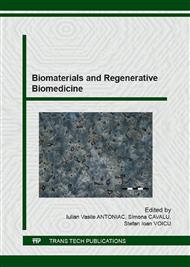[1]
T.C. Lowe, Y.T. Zhu, Commercialization of nanostructured metals produced by severe plastic deformation processing, Advanced Engineering Materials 5 (2003) 373–378.
DOI: 10.1002/adem.200310076
Google Scholar
[2]
Y.T. Zhu, T.C. Lowe, T.G. Langdon, Performance and applications of nanostructured materials produced by severe plastic deformation, Scripta Materialia, 51 (2004), 825-830.
DOI: 10.1016/j.scriptamat.2004.05.006
Google Scholar
[3]
T.C. Lowe, Y.T. Zhu, Deformation Processing in Nanomaterials by Severe Plastic Deformation, Ed. M. Zehetbauer, R.Z. Valiev, in Wiley-VCH, Weinheim, (2004), 789-799.
Google Scholar
[4]
R.Z. Valiev, Y. Estrin, Z. Horita, T.G. Langdon, M.J. Zechetbauer, Y.T. Zhu, Overview Nanostructured Materials, JOM, 58 (2006) 33-39.
DOI: 10.1007/s11837-006-0213-7
Google Scholar
[5]
T.C. Lowe, Outlook for Manufacturing Materials by Severe Plastic Deformation, Mater. Science Forum, 503-504 (2006), 355-362.
DOI: 10.4028/www.scientific.net/msf.503-504.355
Google Scholar
[6]
G.J. Raab, R.Z. Valiev, T.C. Lowe, Y.T. Zhu, Continuous processing of ultrafine grained Al by ECAP–Conform, Materials Science Engineering: A, 382 (2004), 30-34.
DOI: 10.1016/j.msea.2004.04.021
Google Scholar
[7]
R.Z. Valiev, Nanostructuring of Metals by Severe Plastic Deformation for Advanced Properties, Nature Materials, 3 (2004) 511-516.
DOI: 10.1038/nmat1180
Google Scholar
[8]
V.V. Latysh, I.P. Semenova, G.H. Salimgareeva, I.V. Kandarov, Y.T. Zhu, T.C. Lowe, R.Z. Valiev, Microstructure and properties of Ti rods produced by multi-step SPD, Materials Science Forum, 503-504 (2006) 763-768.
DOI: 10.4028/www.scientific.net/msf.503-504.763
Google Scholar
[9]
Information on: http: /www. oeaw. ac. /esi/english/index. html.
Google Scholar
[10]
A. Vorhauer, R. Pippan, On the homogeneity of deformation by high pressure torsion, Scripta Materialia, 51 (2004), 921-925.
DOI: 10.1016/j.scriptamat.2004.04.025
Google Scholar
[11]
T. Hebesberger, H.P. Stüwe, A. Vorhauer, F. Wetscher, R. Pippan, Structure of Cu deformed by high pressure torsion, Acta Materialia, 53 (2005) 393-402.
DOI: 10.1016/j.actamat.2004.09.043
Google Scholar
[12]
A.P. Zhilyaev, G.V. Nurislamova, B.K. Kim, M.D. Baro, J.A. Szpunar, T.G. Langdon, Experimental parameters influencing grain refinement and microstructural evolution during high-pressure torsion, Acta Materialia, 51 (2003) 753-765.
DOI: 10.1016/s1359-6454(02)00466-4
Google Scholar
[13]
G. Sakai, K. Nakamura, Z. Horita, T.G. Langdon, Developing high-pressure torsion for use with bulk samples, Materials Science Engineering: A, 406 (2005) 268-273.
DOI: 10.1016/j.msea.2005.06.049
Google Scholar
[14]
M. Niinomi, Recent research and development in titanium alloys for biomedical applications and healthcare goods, Science and Technology of Advanced Materials, 4 (2003) 445-454.
DOI: 10.1016/j.stam.2003.09.002
Google Scholar


